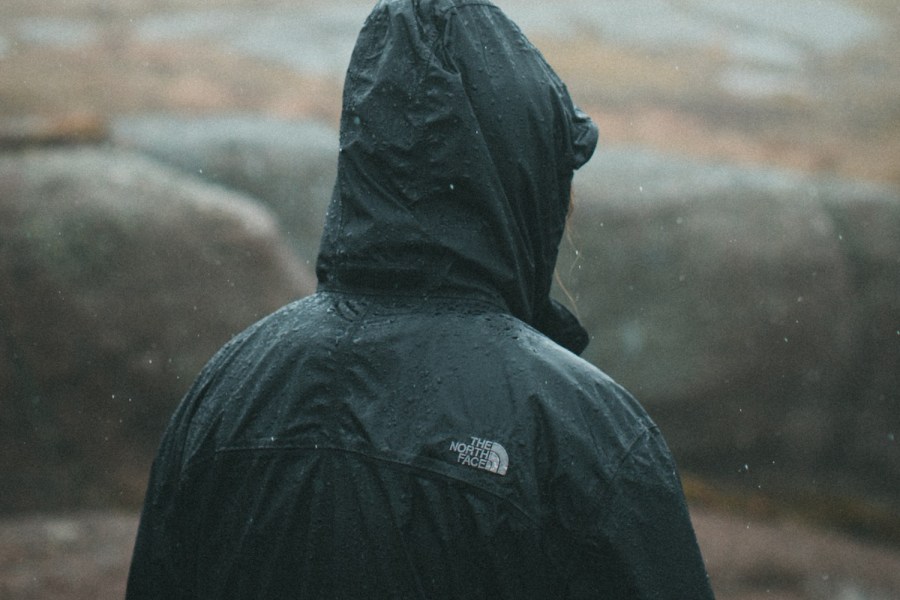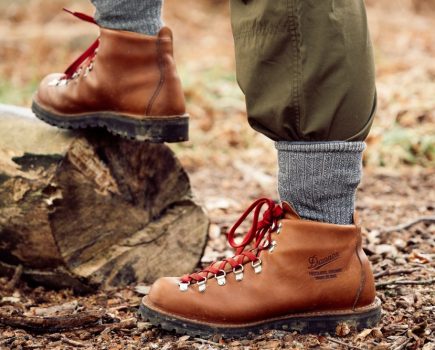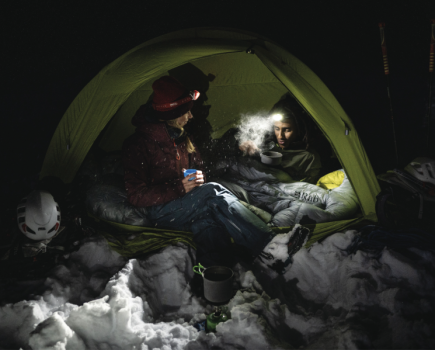Having a good waterproof jacket is a much-needed essential when out hillwalking, especially in the wet weather conditions and up in the mountains where weather forecasts can sometimes throw you curveballs. To help you decide which waterproof jacket is best for you, our team of experts has put together a list of the best mens waterproof jackets.
In our maritime climate, waterproof jackets are one of the most important bits of kit we carry, and making sure they’re right for us requires fit, fabric and features to work together. Obviously, their main job is to keep us dry, but that’s not just from the weather on the outside. We do need them to shed rain, snow and drizzle, and we also need them to breathe and let our sweat out so we’re not wet on the inside. It’s a compromise, because a more breathable membrane is generally less waterproof and vice versa. And at the end of the day, the biggest flaw in jackets is all the holes for our heads and hands, so water will inevitably get in if it’s really wet!
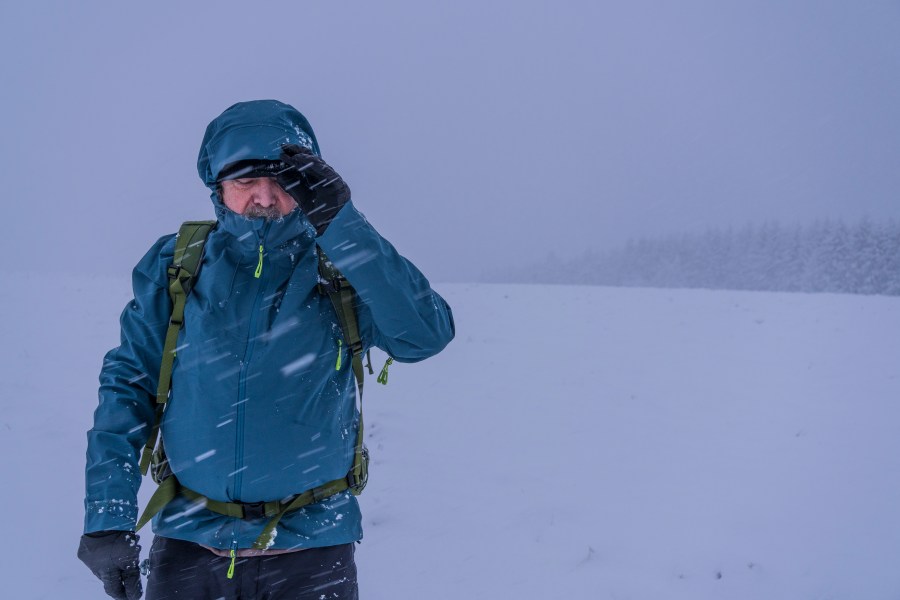
A few features that are important to get right are pockets, fit, hood style, and cuffs. It’s possible to compromise in other ways, but making sure hoods and cuffs fit over layers and gloves, as well as having a good number of pockets in the right place makes life much easier.
Waterproof jackets are often one of the pricier things we buy, so making sure it has everything we want as well as may want if we take up new activities is a big ask! Given how life saving they can be though, it’s not usually a place to scrimp, as you’ll find yourself replacing cheap jackets again and again while one with a higher price tag will last. Winter jackets are often pricier, so if you know you’re not out in full on winter conditions, it may be possible to opt for a lighter, less expensive option.
Why you can trust The Great Outdoors
The Great Outdoors is here to help you make the most of your time outside. We have been helping people to explore from sea to summit, valley to mountain top for over 40 years. Our gear tests remain completely impartial. If you are wary of websites that only review brands that advertise with them, or sceptical of social media accounts always singing the praises of their latest freebie, you’ve come to the right place! Our reviews rank #1 for rigour, trustworthiness, and independence, and our gear testing team is the most experienced in Britain. With over 200 years’ experience between us, we are professional mountain leaders and instructors, wildlife photographers and rangers, outdoor authors, guidebook writers and trail addicts.
The best waterproof jackets for men we’ve tested
This guide contains of the best hardshell jackets for 2025 according to our expert reviewers, Chris Townsend and David Lintern. Most of these are three-season hardshells but there are also options that will suit tough winter trips in snow too. The jackets have been chosen on the basis of their protection, breathability and durability, with weight, packability, features, fit sustainability and value influencing our decisions too.
| Quick List |
|---|
| Best in Test: Montane Cetus Lite – buy now from Montane |
| Greener Choices: Tierra Vastra / Montane Cetus Lite |
| Best Value: Highlander Munro V2 – buy now from Highlander |
| Lightest: Montane Cetus Lite – buy now from Montane |
Best in Test
Montane Cetus Lite
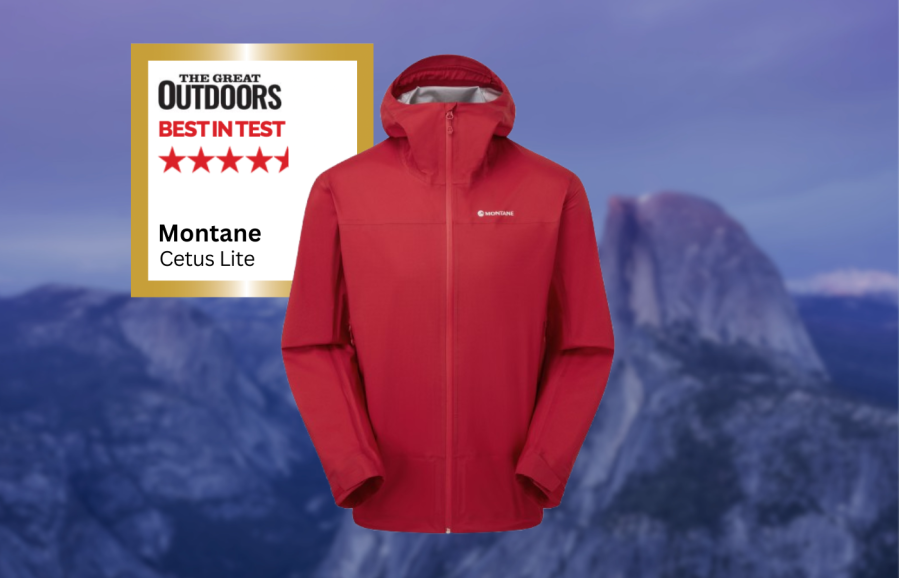
Chris Townsend’s Best in Test & Greener Choice
I think this is a superb three-season hillwalking and backpacking jacket. It’s also my Greener Choice.- breathability
- lightweight
- soft fabric
- recycled fabric
- front drawcords inside jacket
- no chest pocket
| Quick specs |
|---|
| Price: $349 / £270 (available from Montane) |
| Weight: 335g (XL) |
| Materials: PFC – free recycled nylon, hydrophilic polyurethane membrane |
| Hood: front and rear adjustment, wired stiffened peak |
| Front Closure: YKK AquaGuard Zip, inner flap |
| Underarm/Side Zips: No |
| Pockets: 2 hand pockets |
| Hem: Drawcord adjustment |
| Cuffs: Velcro |
| Sizes: S – XXL |
| Women’s version: Yes |
| montane.com |
The Montane Cetus Lite is made from the brand’s new Petrichor Technology, which has a hydrophilic membrane that not only claims to be ‘extremely breathable’ but also to breathe better the harder you work. Big Claims! How do they stack up? Pretty well, in fact.
I’ve worn the jacket in many hours of heavy rain in a wide range of temperatures and wind speeds and have stayed fairly dry inside. Not totally – there has been some condensation at times – but certainly drier than in many other waterproofs. In tests, Petrichor Technology has a Ret value of <5, which puts it in the ‘very good or extremely breathable’ category. I’d agree with ‘very good’. I don’t think any waterproof fabric suitable for the hills is ‘ extremely’ breathable.
Read more: Chris’ full Montane Cetus Lite review
Greener Choice
Tierra Vastra
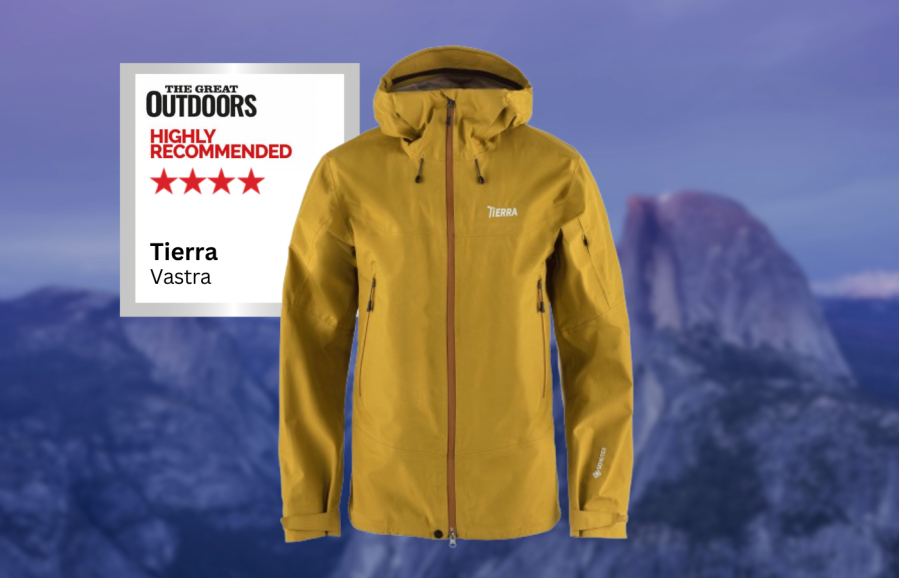
Chris Townsend highly recommends
It is an excellent jacket and suitable for year-round use, though perhaps a little heavy for summer. It’s also my Greener Choice.- ePe Gore-Tex
- hood
- pockets
- side zips
- not that light
- cost
| Quick specs |
|---|
| Price: $465 / £360 (available from Trekitt) |
| Weight: 530g (L) |
| Materials: PFC – free 3 – layer ePE Gore – Tex polyester/polyethylene |
| Hood: front and rear adjustment, wired stiffened peak |
| Front Closure: YKK front zip, inner flap |
| Underarm/Side Zips: side |
| Pockets: 2 mid, 1 sleeve, 2 stretch inner |
| Hem: Drawcord adjustment |
| Cuffs: Velcro |
| Sizes: S – XXL |
| Women’s version: yes |
| tierra.com or trekitt.co.uk |
The Tierra Vastra is made from the new ePe (expanded polyethylene) membrane from Gore-Tex which is fluorocarbon free – unlike the classic Gore-Tex membrane. This is a welcome development. It’s just as waterproof with a hydrostatic head of 28,000 and adequately breathable with a RET of <13. I find it just about impossible to distinguish between the two different Gore-Tex fabrics in use.
The Vastra does rustle a little but has a fairly soft feel. It is comfortable to wear. It is an excellent jacket and suitable for year-round use, though perhaps a little heavy for summer. The cost is quite high but it does have that Gore-Tex name.
Read more: Chris’ full Tierra Vastra review
Outdoor Research Foray
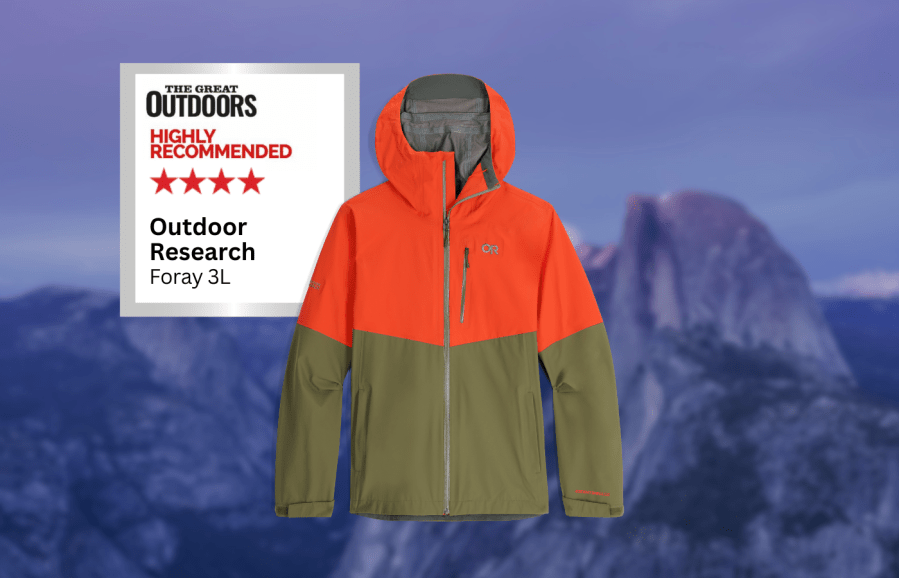
Chris Townsend Highly Recommends
The Foray 3L is comfortable to wear and excellent for three-season use. It’s good in winter weather too, if lacking a stiffer hood.- side vents
- breathability
- soft fabric
- recycled fabric
- front hood drawcords inside jacket
- hood peak could be stiffer
| Quick specs |
|---|
| Price: $336 / £260 (available from Outdoor Research) |
| Weight: 475g (L) |
| Materials: bluesign® Approved PFAS-free AscentShell Dry 3L 100% Recycled Nylon 40D with Nikwax DWR |
| Hood: front and rear adjustment, stiffened peak |
| Front Closure: YKK AquaGuard Zip, inner flap |
| Underarm/Side Zips: full-length two-way side |
| Pockets: 2 hand pockets, 1 chest |
| Hem: Drawcord adjustment |
| Cuffs: Velcro |
| Sizes: XS – XXXL |
| Women’s version: Yes, the Aspire 3L Jacket |
| outdoorresearch.com |
The latest version of the Foray jacket, new last year, is made from AscentShell Dry, which is exclusive to Outdoor Research and made by a complex electrospinning process. The fabric is soft, quiet, slightly stretchy and made from 100% recycled nylon with a Nikwax Direct.Dry DWR that’s also exclusive to Outdoor Research. Outdoor Research says it offers ‘superior breathability’. I’ve certainly found the breathability as good as most. The Foray 3L has an excellent feature that really enhances the comfort – zipped vents that stretch from the biceps to the hem. This allows far more ventilation than standard under arm zips and for dumping excess heat and moist air, venting always beats fabric breathability, so this makes a big difference to comfort. You can even open both sides and wear the jacket as a poncho.
The Foray 3L is comfortable to wear and excellent for three-season use. It’s good in winter weather too, although I’d prefer a stiffer hood peak then.
Read more: Chris’ full Outdoor Research Foray 3L review
Salewa Ortles 3L GTX
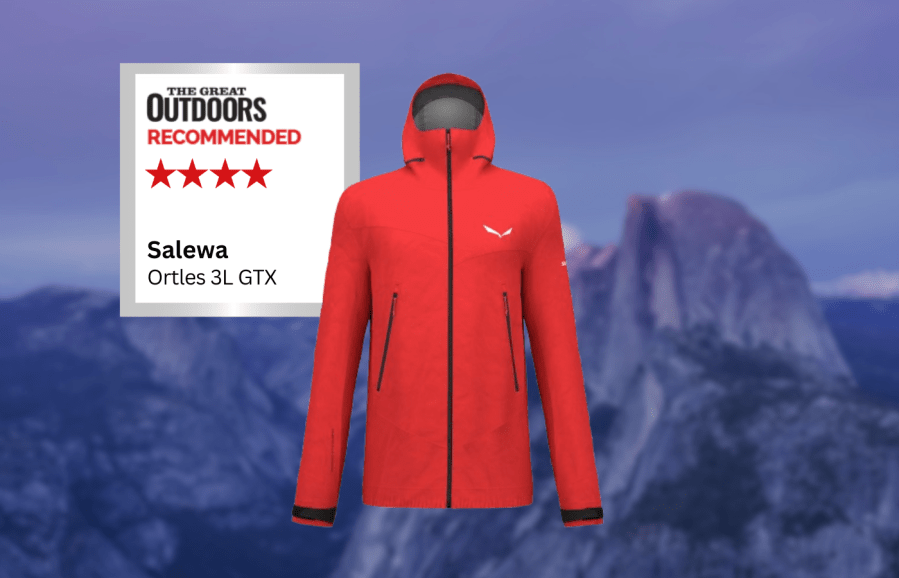
Chris Townsend recommends
The Ortles is the most expensive jacket tested. It is middling in weight and suitable for year-round use.- breathability
- pockets
- hood gusset
- cost
| Quick specs |
|---|
| Price: $470 / £365 (available from Salewa) |
| Weight: 500g (L) |
| Materials: Gore-Tex 2L Paclite Plus/ recycled polyester, Gore-Tex 3L recycled polyester |
| Hood: rear adjustment, zipped gusset for helmet compatibility, stiffened peak |
| Front Closure: YKK waterproof zip, inner flap |
| Underarm/Side Zips: zipped with flap on the back of the upper arms |
| Pockets: 2 mid hand, 2 stretch inner |
| Hem: Drawcord adjustment |
| Cuffs: Velcro |
| Sizes: XS – XXL |
| Women’s version: yes |
| salewa.com |
Unusually, the Ortles jacket is made from two different Gore-Tex fabrics, a durable 3-layer one on the front and upper arms and Paclite on the back, hood, and lower arms for reduced weight and increased packability. The fabrics are quite noisy and a little stiffer than on the other jackets reviewed in this test.
The jacket has a hydrostatic head of 28,000mm and a RET of <9. The last means breathability should be good and it is. I have to work quite hard to produce much condensation inside. When overheating does occur, there are zipped vents on the back of the upper arms. These aren’t as effective as underarm zips but are easier to use as they don’t run under pack shoulder straps.
The Ortles is the most expensive jacket tested. It’s mid-range in weight and suitable for year-round use.
Read more: Chris’ full Salewa Ortles 3L GTX review
Best value
Highlander Munro V2
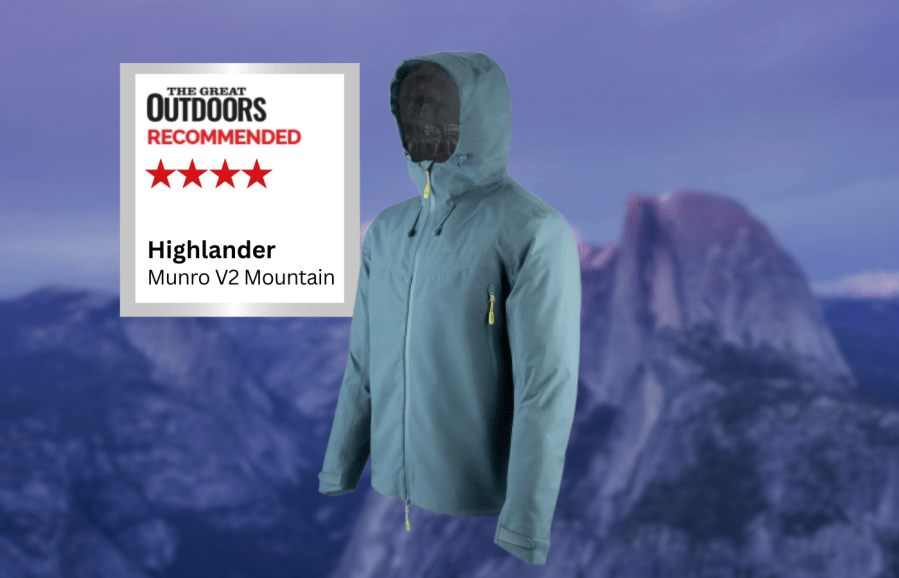
Chris Townsend’s Best Value
The Munro Jacket is comfortable and I’ve been happy wearing it in storms. It may be inexpensive but it doesn’t feel like a budget garment.- hood
- cost
- quite heavy
- no women’s version
| Quick specs |
|---|
| Price: $232 / £180 (available from Highlander) |
| Weight: 580g (L) |
| Materials: 3 – layer PROT3X PFC Free polyester |
| Hood: front and rear adjustment, wired stiffened peak |
| Front Closure: YKK waterproof zip, inner flap |
| Underarm/Side Zips: two-way YKK zips |
| Pockets: two harness/hipbelt compatible, 1 inner |
| Hem: Drawcord adjustment |
| Cuffs: cuffs |
| Sizes: S – 2XL |
| Women’s version: no |
| highlander-outdoor.com |
The Highlander Munro V2 Mountain Jacket is a fully specified jacket suitable for year-round use at a low cost, making it superb value for money. The hydrostatic head rating of 20,000mm (the height of a column of water that can stand on the fabric before it leaks) compares well with that of many far more expensive jackets. In heavy rain it has proved fully waterproof. Breathability however is on the low side at 15,000 MVTR (Moisture Vapour Transmission Rate). Top end jackets are usually at least 20,000. In practice I have found condensation appearing inside a bit sooner than with the other jackets tested but it’s not been a problem. A main reason for this is that the Munro has long underarm zips so damp air can be easily expelled. This is an excellent feature, especially given the price.
The Munro Jacket is comfortable and I’ve been happy wearing it in storms. It may be inexpensive but it doesn’t feel like a budget garment. It is quite heavy, the heaviest jacket tested, and maybe overkill for summer backpacking, but at the same time it’s adequate for winter mountain use.
Read more: Chris’ full Highlander Munro V2 review
Montane Phase Nano
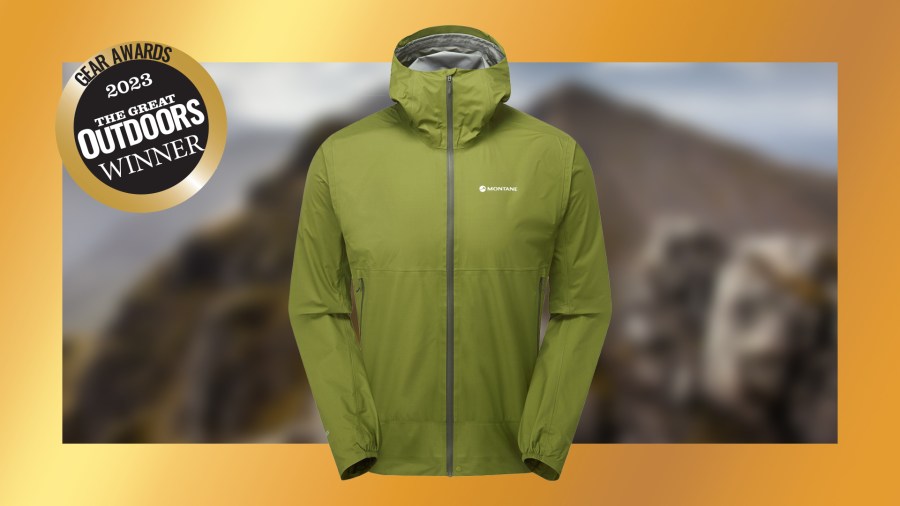
Winner in TGO Awards 2023
“It packs to nothing for just-in-case days, the Gore-Tex fabric is excellent, it has good-sized pockets and it gives perfect articulation with no hem movement at all.”- Low weight
- Breathability
- Packability
- Expensive
- No cuff adjustment
| Quick specs | |
|---|---|
| Price | $379 / £300 (Montane & Go Outdoors) |
| Weight | 250g |
| Materials | 13D Gore-Tex Active, YKK Aquaguard zips |
| Pockets | two hand pockets |
| Hood | 3-point adjustable with stiffened peak |
| Sizes | men S-XXL (no direct women’s version; nearest equivalent is the Phase or Phase XT) |
Montane describes the Phase Nano as the lightest and most breathable Gore-Tex waterproof jacket it offers. Weighing just 250g, it’s a jacket that offers three-layer waterproof protection alongside a bunch of useful design details, including a full length water resistant front zip, a three-point adjustable hood and shaped cuffs.
“It’s a great bit of kit,” said Peter Macfarlane who was on the jury that selected this as the best rain jacket in this year’s Great Outdoors Awards. “It packs to nothing for just-in-case days, the Gore-Tex fabric is excellent, it has good-sized pockets and it gives perfect articulation with no hem movement at all.”
It features Gore-Tex Active, a lightweight version of Gore’s three-layer waterproof fabric that’s designed for high levels of breathability. It’s specifically made for trail running but its three-way adjustable hood, big hand warmer pockets and storm flap make it a good option for summer hikes too – though the 13D fabric might be a little thin to wear with a heavily loaded pack. The phase Nano is now available for both men and women.
Available at: montane.com
Patagonia Granite Crest
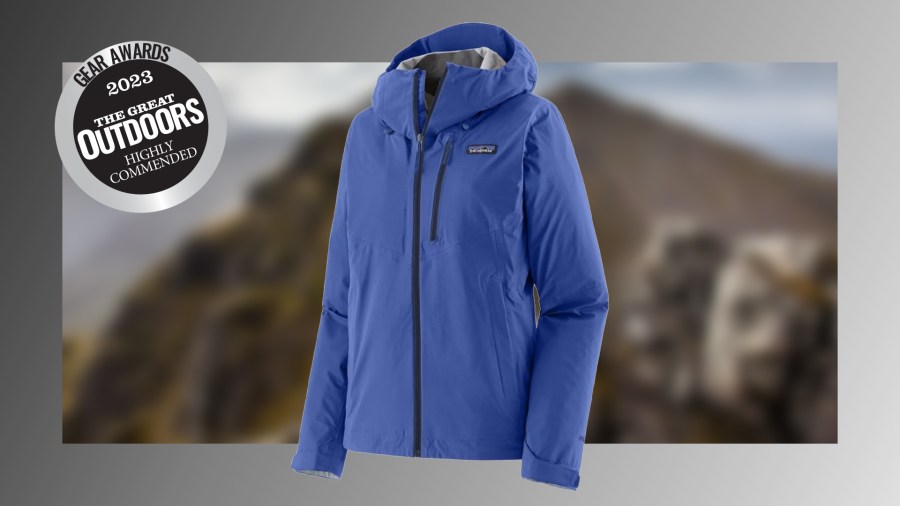
Highly Commended – TGO Awards 2023
From our tests, we found it to be a great three-season option that would be excellent for day hiking and backpacking.- Lightweight
- Hood adjustment
- Recycled Fabrics
- Underarm zips
- Cost
- Hood peak not stiff
| Quick specs | |
|---|---|
| Price | £260 (cotswoldoutdoor.com) |
| Weight | 395g (M) |
| Materials | 3-layer H2No Performance Standard NetPlus post-consumer recycled nylon ripstop with PFC-free DWR |
| Hood | helmet-compatible, front and rear adjustment, stiffened peak |
| Front Closure | zip with internal storm flap, bottom popper |
| Underarm/side zips | Two way |
| Pockets | 2 handwarmer, 1 chest |
| Hem | Adjustable drawcord |
| Cuffs | Velcro |
| Sizes | men XS-XXL (women XS-XL) |
“You’ve got everything you’d want from a good, reliable wet weather shell,” said Will Renwick who was on the jury that chose this as Highly Commended in The Great Outdoors Awards 2023. He tested the Patagonia Granite Crest over the course of a wet backpacking trip in the Lake District.
Not only is the Granite Crest PFC-free but it also uses a fabric that’s made from recycled fishing nets in order to help to reduce ocean plastic pollution. This fabric has a good quality feel to it too; it’s soft to the touch and quiet and there’s a slight stretch to it.
From our tests, we found it to be a great three-season option that would be excellent for day hiking and backpacking. It has a huge helmet-compatible hood that can be adjusted to give good protection whilst allowing visibility, the front drawcords are external ones and so are easily tightened with the jacket fully zipped up and it has a stiffened peak too – though this lacks structure and can distort in the wind.
Other features include large hand pockets, a fully sized chest pocket that can accommodate a map, and long underarm zips for ventilation.
Read our full Patagonia Granite Crest review.
Available at: cotswoldoutdoor.com
Rab Namche
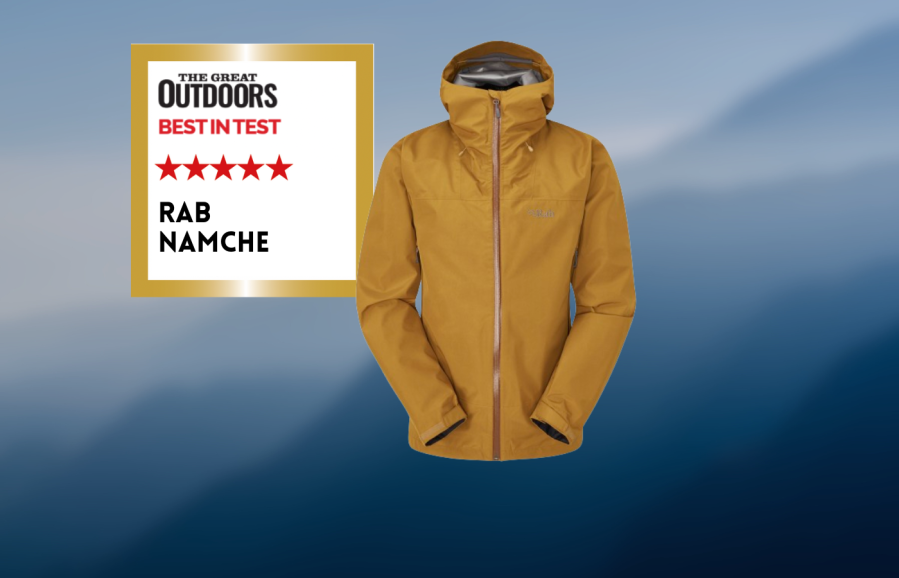
Chris Townsend’s Best in test 2024
The Namche is one of the best jackets I tested for year-round use as it’s substantial enough for severe winter weather but not too heavy or bulky for summer.- Pockets
- Hood
- recycled fabric, PFC-free membrane & DWR
- None
| Quick specs | |
|---|---|
| Price | $350 | £290 |
| Weight | 450g (size UK L |
| Materials | Gore-Tex 3-layer 75D recycled polyester with ePe membrane |
| Hood | Wired and stiffened peak, rear and side adjusters |
| Sizes | S-XXL |
| Women’s version | Yes |
The RAB Namche is a lightweight, durable hardshell waterproof jacket suitable for year-round use, suitable for severe winter weather but not too heavy for summer. It features a PFC-free Gore-Tex ePe membrane, providing a slightly softer feel than similar jackets with old ePTFE membranes. The jacket’s face and backing fabric are 100% recycled polyester, with 50% recycled content. The minimalist design is functional, with a helmet-compatible hood for easy adjustment and a wired peak for side visibility. The jacket has only two large pockets, but they are comfortable and angled for hands. Underarm zips for ventilation are easy to use, and the cuffs are wide enough for ventilation and can be cinched tight. The RAB Namche is a superb jacket, except for a helmet-compatible hood or multiple pockets.
Read Chris’ full Rab Namche Waterproof Jacket Review – Tested across Winter 2023/2024
Helly Hansen Odin 9 Worlds 3.0
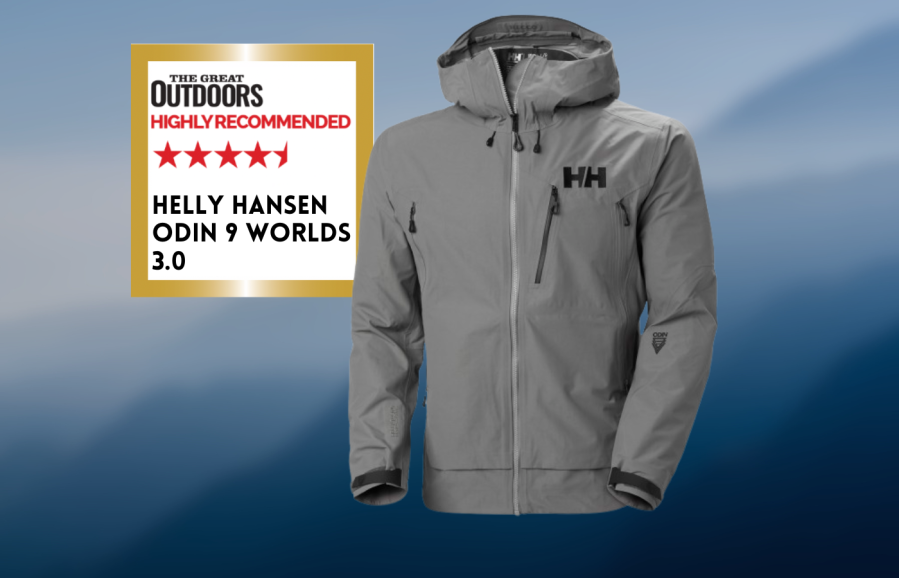
Highly Recommended
For winter mountains this is a great jacket. It is quite heavy though and overkill for summer.- Hood
- Pockets
- Recycled Content
- Weight
- Price
| Quick specs | |
|---|---|
| Price | $475 / £440 (TrekInn) |
| Weight | 610g (size UK XL) |
| Materials | Helly Tech Professional 3-layer 68% recycled polyamide/32% polyamide |
| Hood | wired and laminated peak, rear and side adjusters, helmet compatible |
| Sizes | S-2XL |
| Women’s version | Yes |
Helly Hansen provided an XL size Odin 9 Worlds 3.0 waterproof jacket, allowing it to be worn over an insulated jacket without feeling tight. This jacket is designed for burly winter weather and is lightweight and stiff. The front pockets are double-layer, providing excellent breathability. The hood is helmet-compatible and can be closed around a hat or bare head. The jacket has large pockets that can hold a large amount of gear, with double zip pullers for easy access. A smaller chest pocket is ideal for a compass or smartphone. The underarm zips have double zip pullers, but they are stiff and awkward to use. Wide cuffs fit over gloves and allow ventilation. While this jacket is great for winter mountains, it is heavy and overkill for summer.
Read Chris Townsend’s full Helly Hansen Odin 9 Worlds 3.0 Review – Tested across Winter 2023/2024
Paramo Velez Adventure Smock
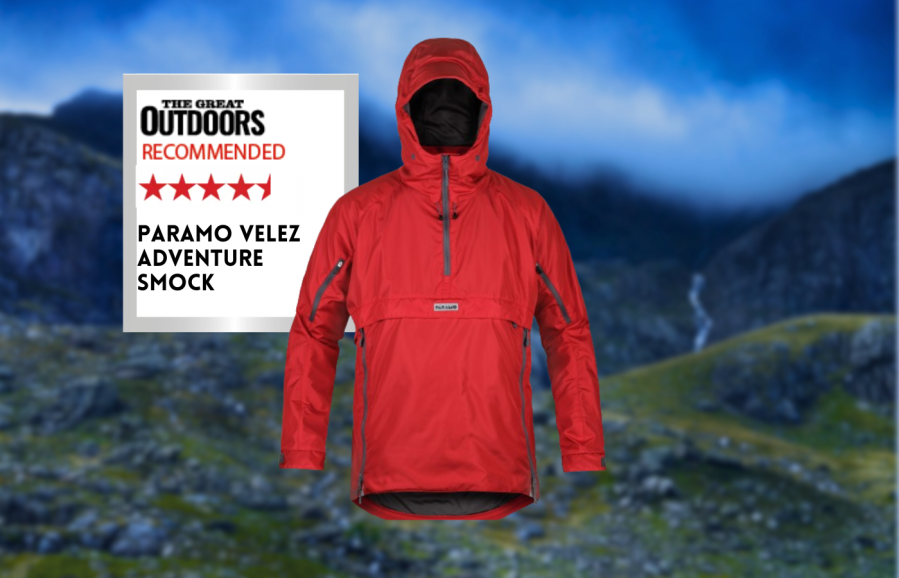
TGO Recommends
The Velez Adventure Smock is warmer than a conventional waterproof jacket, so you don’t need to wear as much under it. I find it excellent in cold winter weather.- Comfort
- Breathability
- Hood
- Pockets
- Heavy
- Too warm for summer
| Quick specs | |
|---|---|
| Price | £280 |
| Weight | 810g (Uk size L) |
| Materials | Nikwax Analogy Waterproof polyester fabric |
| Hood | wired and laminated peak rear and side adjusters |
| Sizes | S-XXL |
| Women’s Version | Yes |
Paramo waterproof jackets have two layers of material, one for wind deflection and the other for moisture removal. They are effective when kept clean and treated with Nikwax TX.Direct. They are breathable and comfortable, but not light and best worn all day. The Velez Adventure Smock is designed for high-energy activities in cold and wet conditions, offering excellent ventilation with two long two-way front zips and zipped upper arm vents. The hood has a wired peak for protection without hindering vision. The smock has a large kangaroo pocket for maps and other items, a small zipped pocket inside for compass and phone, and another zipped pocket across the front. The main front zips can be partially unzipped to warm hands. The Velez Adventure Smock is warmer than conventional waterproof jackets, making it ideal for cold winter weather.
Read Chris Townsend’s full Paramo Velez Adventure Smock Review, – Tested across Winter 2023/2024
Patagonia Triolet
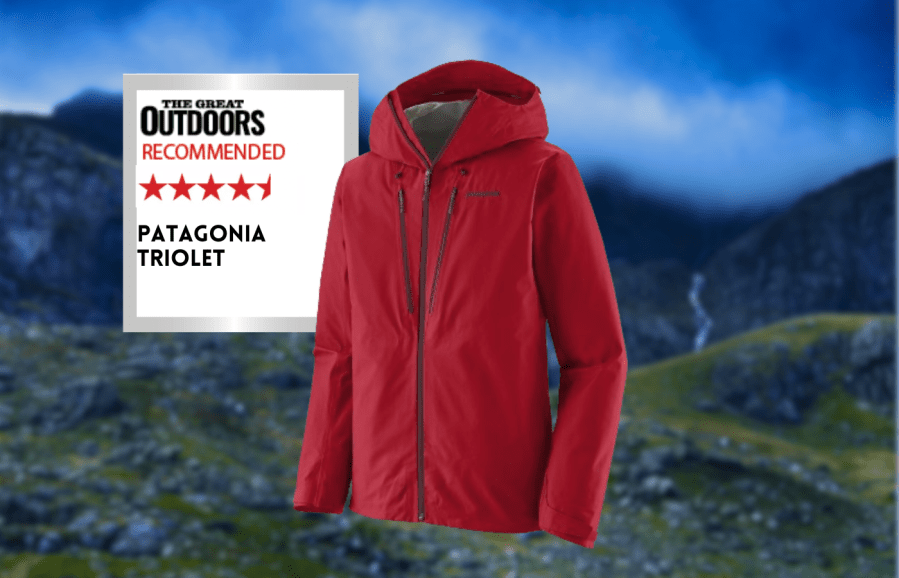
TGO Recommends
For mountaineering where a climbing helmet is worn the Triolet is an excellent jacket. It works fine for hillwalking too, if you can manage with the over-sized hood.- Pockets
- recycled fabric, PFC-free membrane & DWR
- Huge hood is hard to adjust
- Cost
| Quick specs | |
|---|---|
| Price | $449 | £390 |
| Weight | 550g (size UK L) |
| Materials | Gore-Tex 3-layer 75D recycled polyester with ePe membrane. |
| Hood | Wired and laminated peak, rear and side adjusters, helmet compatible |
| Sizes | XS-XXL |
| Women’s version | Yes |
The Triolet is a waterproof jacket designed for alpine workhorses, featuring a helmet-compatible hood and a RECCO reflector for searchability by rescuers. The fabric is soft and flexible, similar to Rab Namche, and offers comparable breathability to the Gore-Tex ePTFE membrane. The hood is large and can be cinched down around a hat or bare head, providing excellent protection. The two large chest pockets hold maps but are not suitable for handwarmers. The underarm zips run freely and have double zip pullers, allowing for easy opening or closing. The cuffs are wide enough for ventilation and fit over gloves. The Triolet is an excellent choice for mountaineering and hillwalking, especially if a climbing helmet is worn. The jacket is suitable for both mountaineering and hillwalking, provided the over-sized hood is worn.
Read Chris Townsend’s full Patagonia Triolet Waterproof Jacket Review – Tested across Winter 2023/2024
RAB Arc Eco

TGO Magazine verdict
Perhaps not a rain jacket for the depths of winter but it is a light, simple, cheap and more environmentally-friendly option for backpacking and hillwalking.- Eco credentials
- Great all-rounder
- Cost
- Needs more pockets
| Quick specs | |
|---|---|
| Price | $235 | £200 |
| Weight | 436g |
| Materials | 3-layer Pertex Shield recycled polyester ‘Revolve’, recycled inner, PFC-free DWR |
| Features | Part-wired 3-way adjustable hood, 2 large pockets |
| Sizes | S-XXL |
| Women’s version | Yes |
The Rab Arc Eco was given Gold in our TGO awards for sustainability and it has really stood out from the other men’s waterproofs here too. On test since last autumn, the fully recycled fabric has so far resisted wear and tear, with the 20,000 hydrostatic head and 15,000 MVTR (breathability rating), continuing to keep us completely dry.
Our tester found the cut of the jacket is quite long, and perhaps overly roomy at the chest, but this does at least allow for layering. The sleeves are Velcro-adjusted, and the hem adjusted by two toggles. As for pockets, there are only two very large handwarmers, situated just high enough to be useable whilst wearing a rucksack.
Perhaps not a rain jacket for the depths of winter but it is a light, simple, cheap and more environmentally-friendly option for backpacking and hillwalking.
Read our David Lintern’s full Rab Arc Eco review. – Tested in 2023
How we tested
Chris tested his jackets on day walks and multi day trips in the Scottish Highlands from spring 2024 through to early 2025. He is short and mostly wears a size large. Conditions included heavy rain, soaking drizzle, blizzards, and ferocious winds. Additional waterproof jackets for men were tested by Chris Townsend and David Lintern over the winter of 2023 and into 2024. Chris and David tested these jackets in a variety of conditions and areas in the UK.
All weights are taken from the reviewer’s own scales. Most of the jackets tested are three-season hardshells but there are also options that will suit tough winter trips in snow too. The jackets have been chosen on the basis of their protection, breathability and durability, with weight, packability, features, fit sustainability and value influencing our decisions too.
How to choose the best waterproof jacket for you
Finding the right waterproof jacket can greatly enhance your comfort and performance in adverse weather conditions. It’s also absolutely crucial from a safety perspective. First and foremost, the main things to assess when choosing a rain jacket are the levels of waterproofness and breathability as these determine its ability to keep you dry while allowing moisture to escape. Additionally, consider the hardshell jacket’s durability, weight, and packability to match your intended activities and environment. If you like to move fast and light, for instance, then a lightweight 2.5-layer shell that’s light on features will be best for you. Conversely, if you’re into your winter mountaineering then you’ll want a more durable shell – 3-layer perhaps – with pockets and lots of adjustment.
Pay attention to features like hood design: is there adjustment so that it will hold in high winds? And pocket placement: will they be accessible when you’re wearing a baclpack with a hipbelt? You’ll also want to take into account the jacket’s fit and sizing to ensure optimal comfort and freedom of movement – many of our full individual jacket reviews will specify whether a jacket is true to size or not. If we don’t specify in the review, please feel free to get in touch with us directly to ask.
Finally there’s the sustainability side of things. If you’re conscious of the environmental impact of products, check whether any recycled materials are present and also whether the materials can go on to be recycled when the jacket comes to the end of its life. Some jackets these days still come with PFCs. These are water resistant chemicals that often escape through our washing machines and into the world’s water supplies where they stay for a very long time. Studies have found these in the world’s deepest oceans and even on the summit of Everest!
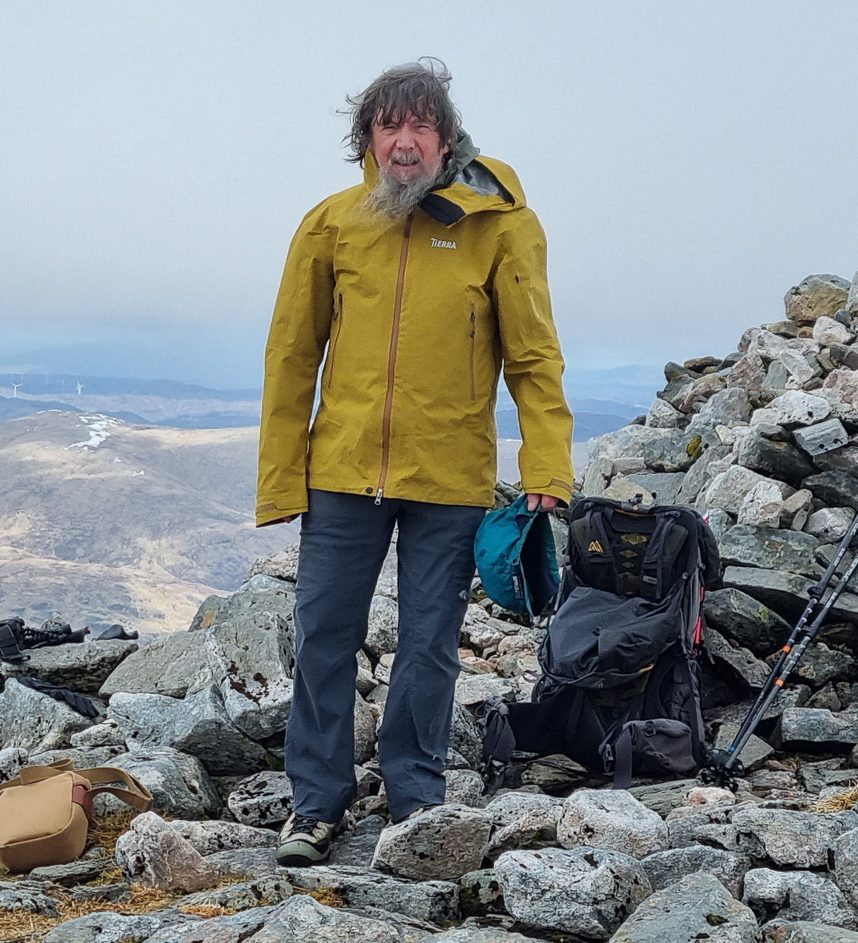
Fabric
The fabric determines how ‘breathable’ a garment will be. All waterproof fabrics are fully waterproof regardless of cost. Thicker fabrics give better protection in winter weather.
Construction
Waterproof fabrics are made up of layers of material. The most durable construction is three-layer in which the waterproof layer is sandwiched between the face fabric and an inner layer.
Hood
Hoods should be easily adjusted and move with your head. A wired or stiffened peak is useful in wind driven rain and snow. Helmet-compatible hoods should have volume adjusters so they can be reduced in size without affecting your vision for non-helmet wear.
Front Closure
Water-resistant zips are now standard. These are not fully waterproof in driving rain and should have an inner flap to repel any rain that gets through.
Ventilation
Underarm/side zips can be awkward to use but do allow good ventilation. They can often be used when the front zip has to be closed due to rain or snow. Zips that curve under the armpits are effective but the most difficult to adjust. Side zips that run from the armpit down the jacket are much easier to use.
Cuffs
Cuffs that can be opened wide are good for ventilation in the arms. Elasticised and narrow cuffs can lead to sweaty wrists.
Pockets
Whilst not essential pockets that are accessible when wearing a rucksack hipbelt are useful for items like compass, phone, snacks, map, hat and gloves.
DWR
The durable water repellency treatment (DWR) makes water bead and run off fabrics. In time this degrades and needs to be restored with a wash-in or spray-on product. The DWR does not affect the waterproofness of a garment but does reduce the breathability when it wears off gets dirty so you get more condensation inside. The DWR treatment used for many decades is being phased out as it contains environmentally damaging PFCs. Unfortunately, PFC-free DWRs do not last as long so garments need washing and reproofing more often.
Fit
For the most efficient breathability, the best waterproof jackets should fit fairly closely. At the same time, they shouldn’t be so tight that they restrict movement. And a rain jacket should fit comfortably over all the layers you might need to wear underneath it. Size labels should be taken as a guide only – they’re not consistent between makes.
Waterpoofing, breathability, adjustment, fit, features, sustainability and of course price. There’s a lot to consider, but by carefully weighing these up you can make a well-informed choice and invest in a waterproof shell that could serve you well and for a long, long time.
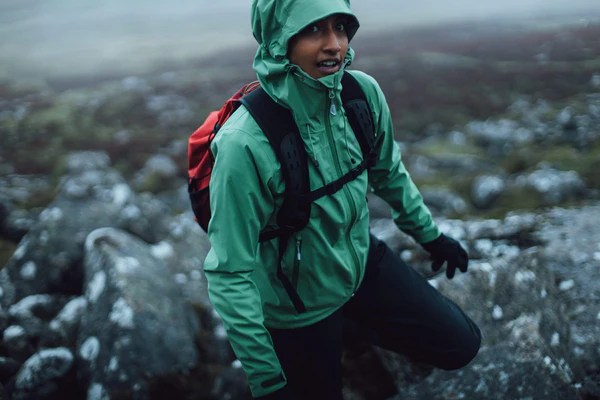
Measuring waterproofness and breathability
If you want to know how to stay dry when hiking in the rain, it’s important to consider a rain jacket’s waterproofness and breathability. If the weather is wet and warm, the fabric needs to have the capacity to let the moisture created by sweat to escape, otherwise you will end up damp inside the rain jacket. These days there are excellent waterproof and breathable membranes (which are also windproof). Most jackets also have a durable waterproof repellency (DWR) treatment added to the outer layer of fabric.
The waterproofness of a rain jacket is measured by determining the height of a column of water that the fabric can withstand before it starts to leak through. The resulting figure is known as the hydrostatic head (HH) and this is expressed in millimetres – the higher the number, the more waterproof the jacket is considered to be.
The breathability of waterproof garments is determined by the “Moisture Vapor Transmission Rate” (MVTR). This test measures the amount of water vapor that can pass through the jacket’s fabric over a given period of time. The unit of measurement used is typically grams per square meter per 24 hours (g/m²/24h). The higher the MVTR rating, the more breathable the jacket is considered to be.
Finally, colour choice may seem less important but a brighter shade will allow you to be more easily seen should you get into difficulty. Black, dark blues and greens blend in rather than stand out. Also, very light shades will show the dirt quickly.
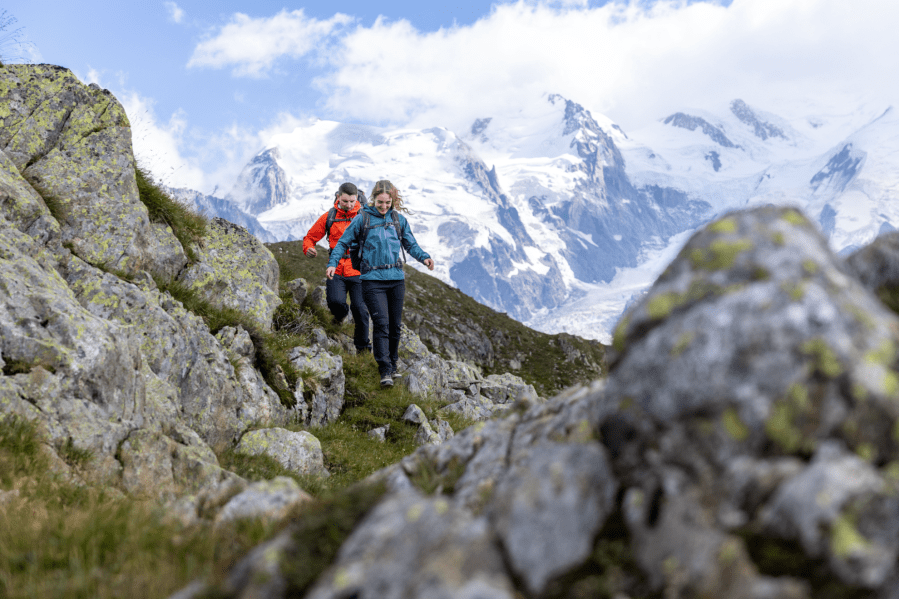
Waterproof fabrics and their ratings
- Hydroshell (Berghaus) – HH: 15,000 mm | MVTR: 20,000 g/m²/24h (official)
- Dermizax EV – HH: 25,000 mm | MVTR: 20,000 g/m²/24h (official)
- Unbranded (Alpkit Balance) – HH: 20,000 mm | MVTR: 20,000 g/m²/24h (official)
- Polartec Power Shield – HH: 20,000 mm | MVTR: 20,000 g/m²/24h (official)
- Futurelight (The North Face) – HH: Unknown | MVTR: 75,000 g/m²/24h (official)
- Pertex Shield – HH: 20,000 mm | MVTR: 20,000 g/m²/24h (estimated)
- H2No (Patagonia) – HH: 10,000mm to 20,000 mm | MVTR: 12,000 – 15,000 g/m²/24h (estimated)
- Omni-Tech (Columbia) – HH: 10,000 mm | MVTR: 10,000 g/m²/24h (estimated)
- eVent – HH: 30,000 | MVTR: 15,000 to 25,000 g/m²/24h (estimated)
- Gore-tex – HH: 28,000 mm | MVTR: 17,000 g/m²/24h (estimated)
- Gore-tec Paclite – HH: 28,000 mm | MVTR:15,000 g/m²/24h (estimated)
- Gore-tex Pro – HH 28,000 mm | MVTR: 25,000 g/m²/24h (estimated)
How to look after your waterproof jacket
Looking after waterproof jackets can be trickier than a normal piece of clothing; they require a certain amount of upkeep if they are to continue to keep you dry and perform well for a long time. Dirty rain jackets don’t let body moisture through very well, so you get damp from condensation building up inside the rain jacket as you sweat quicker. The Durable Water Repellency (DWR) treatment on the outside of hardshell jackets that causes rain to bead and run off rather than soak in can also wear off and need replacing over time. This also leads to condensation as the garment is then less breathable.
There are two main elements to waterproof jacket care: washing, and restoring the jacket’s DWR treatment. Our guide on how to look after your waterproof jacket will further help you to understand common problems with hardshells, rain jackets and how to manage them.
How to repair your waterproof
To repair a small hole or tear you will need:
- Duct tape
- Seam sealant
How to do it: Patch over with tape (do this on both sides if possible). Reinforce edges with seam sealant. You could also use a Gore-Tex repair kit. You can use duct tape on clothing and sleeping bags. I have down jackets and bags with duct tape patches that have been there for years). I’ve never had to repair a softshell jacket but if there was a big hole or rip I’d just stick duct tape on it. Of course, a hole in softshell or fleece is more significant compared to one in a waterproof.
Learn more about how to repair your waterproof jacket.

